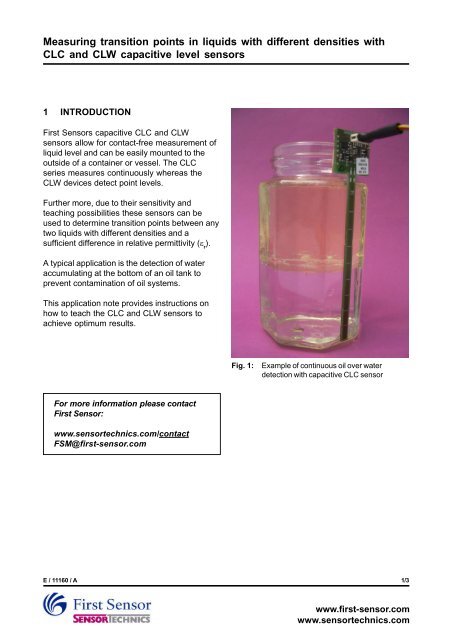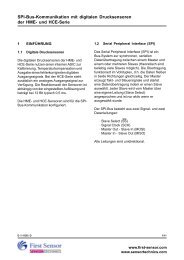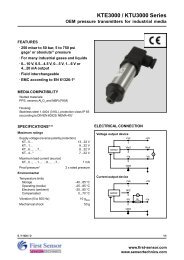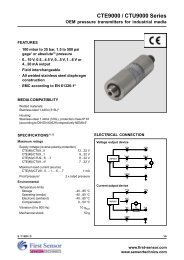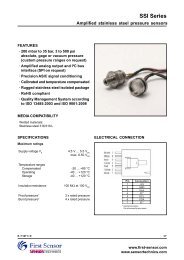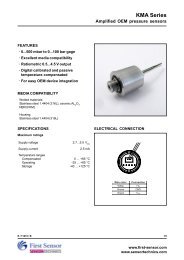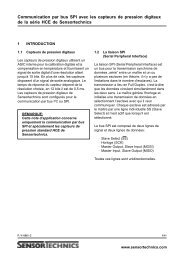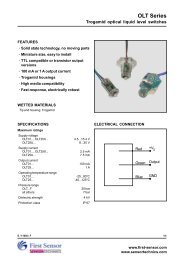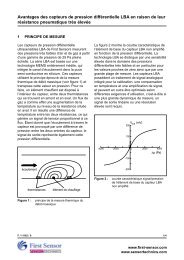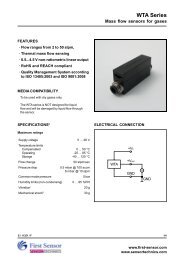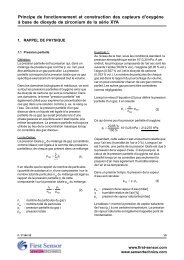Measuring transition points in liquids with different ... - Sensortechnics
Measuring transition points in liquids with different ... - Sensortechnics
Measuring transition points in liquids with different ... - Sensortechnics
Create successful ePaper yourself
Turn your PDF publications into a flip-book with our unique Google optimized e-Paper software.
<strong>Measur<strong>in</strong>g</strong> <strong>transition</strong> <strong>po<strong>in</strong>ts</strong> <strong>in</strong> <strong>liquids</strong> <strong>with</strong> <strong>different</strong> densities <strong>with</strong>CLC and CLW capacitive level sensors1 INTRODUCTIONFirst Sensors capacitive CLC and CLWsensors allow for contact-free measurement ofliquid level and can be easily mounted to theoutside of a conta<strong>in</strong>er or vessel. The CLCseries measures cont<strong>in</strong>uously whereas theCLW devices detect po<strong>in</strong>t levels.Further more, due to their sensitivity andteach<strong>in</strong>g possibilities these sensors can beused to determ<strong>in</strong>e <strong>transition</strong> <strong>po<strong>in</strong>ts</strong> between anytwo <strong>liquids</strong> <strong>with</strong> <strong>different</strong> densities and asufficient difference <strong>in</strong> relative permittivity (ε r).A typical application is the detection of wateraccumulat<strong>in</strong>g at the bottom of an oil tank toprevent contam<strong>in</strong>ation of oil systems.This application note provides <strong>in</strong>structions onhow to teach the CLC and CLW sensors toachieve optimum results.Fig. 1:Example of cont<strong>in</strong>uous oil over waterdetection <strong>with</strong> capacitive CLC sensorFor more <strong>in</strong>formation please contactFirst Sensor:www.sensortechnics.com/contactFSM@first-sensor.comE / 11160 / A1/3www.first-sensor.comwww.sensortechnics.com
<strong>Measur<strong>in</strong>g</strong> <strong>transition</strong> <strong>po<strong>in</strong>ts</strong> <strong>in</strong> <strong>liquids</strong> <strong>with</strong> <strong>different</strong> densities <strong>with</strong>CLC and CLW capacitive level sensors2 OIL OVER WATER DETECTION2.1 Cont<strong>in</strong>uous detection of the water level<strong>in</strong> an oil tankOilWaterCLCsensorTeachablemeasurementrange (100 mm)Teach-<strong>in</strong> procedure1. Attach the CLC sensor to the tank so thatthe tip of the sensor pad reaches thebottom of the conta<strong>in</strong>er (see teachablemeasurement range <strong>in</strong> Fig. 2).2. Fill the conta<strong>in</strong>er <strong>with</strong> the liquid which hasthe lower ε r(<strong>in</strong> this application the oil) sothat at least the complete sensor pad iscovered.3. Teach the CLC sensor to LOW level4. Fill the conta<strong>in</strong>er <strong>with</strong> the liquid which hasthe higher ε r(<strong>in</strong> this application the water)to the desired maximum level. For bestresults the complete sensor pad (100 mm)should be covered.5. Teach the CLC sensor to HIGH levelConta<strong>in</strong>er wallFig. 2:Setup of cont<strong>in</strong>uous oil over water detectionFig. 3:Level visualisation for cont<strong>in</strong>uous oil overwater detection (here approx. 50 mm ofwater from bottom of the tank). For levelvisualisation an RS232 adapter may be usedto convert the 1-wire signal given by theCLC sensor.E / 11160 / A2/3www.first-sensor.comwww.sensortechnics.com


